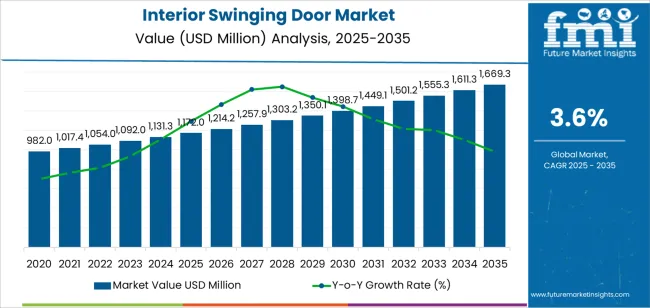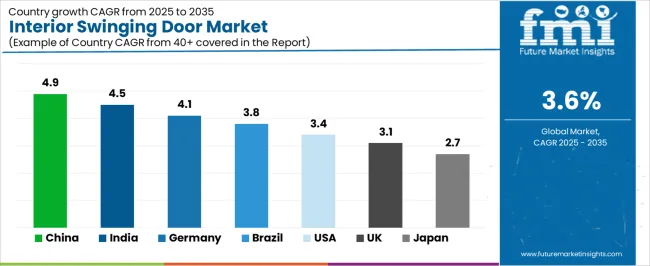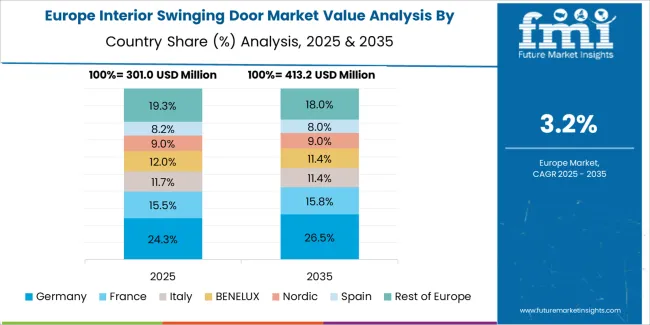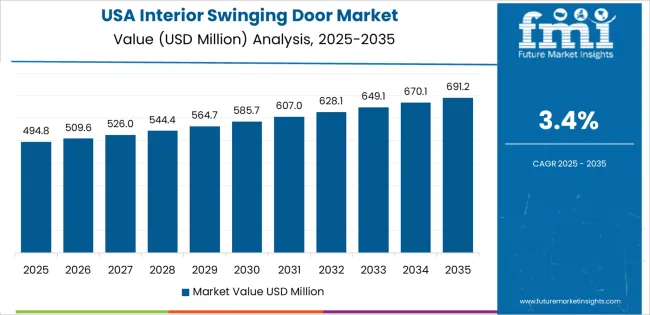The global interior swinging door market is projected to reach USD 1,669.3 million by 2035, reflecting an absolute increase of USD 497.3 million over the forecast period. The market, valued at USD 1,172 million in 2025, is expected to grow at a CAGR of 3.6%. This growth is primarily driven by the increasing demand for interior doors in residential, commercial, and industrial buildings, with a particular focus on aesthetics, functionality, and space optimization.
Interior swinging doors are a popular choice for both modern and traditional spaces, offering a variety of design options and functionalities, from single-panel to double-panel doors. These doors are widely used in residential homes, office buildings, hotels, and healthcare facilities, where they provide easy access, effective separation of spaces, and design flexibility. The growing trend of open floor plans and multifunctional spaces in residential and commercial sectors is boosting the demand for interior swinging doors, as they allow for both privacy and openness.

The increasing focus on aesthetics and customization, with a wide range of finishes, materials, and designs available, is also contributing to the market's growth. Homeowners and businesses are increasingly investing in high-quality, visually appealing interior doors that complement their décor and add to the overall look and feel of their spaces. Advancements in materials and manufacturing technologies are driving the adoption of new, more durable door solutions that require less maintenance and offer greater longevity.
Between 2025 and 2030, the interior swinging door market is projected to grow from USD 1,172 million to approximately USD 1,452 million, adding USD 280 million, which accounts for about 56.4% of the total forecasted growth for the decade. This period will see an increased focus on residential and commercial building renovations, as well as the growing demand for customizable, stylish, and functional interior door solutions.
From 2030 to 2035, the market is expected to expand from approximately USD 1,452 million to USD 1,669.3 million, adding USD 217.3 million, which constitutes about 43.6% of the overall growth. This phase will be characterized by continued innovation in door designs, including smarter solutions integrated with home automation systems, as well as the increased adoption of interior swinging doors in both new builds and renovation projects. The focus on improving building functionality, aesthetics, and design will drive sustained demand for interior swinging doors during this period.
| Metric | Value |
|---|---|
| Market Value (2025) | USD 1,172 million |
| Market Forecast Value (2035) | USD 1,669.3 million |
| Forecast CAGR (2025-2035) | 3.6% |
The interior swinging door market is growing as demand for functional and aesthetically pleasing door solutions increases across residential, commercial, and institutional buildings. Interior swinging doors, known for their ease of use and space-saving design, are highly favored in environments where convenience and style are essential. These doors are widely used in homes, offices, hotels, and healthcare facilities, where they provide a practical and efficient way to separate rooms while maintaining a fluid, open feel.
The growth of the construction industry, particularly in urban and residential developments, is driving demand for interior swinging doors. As new homes, offices, and commercial buildings are built, interior swinging doors are increasingly being installed for their versatility, ease of operation, and suitability for various spaces. The growing trend of home improvement and renovation projects is contributing to the replacement and installation of high-quality interior doors, further boosting market growth.
Advancements in materials, such as enhanced wood finishes, eco-friendly composites, and improved hardware, have also increased the appeal of interior swinging doors. These innovations not only improve durability and performance but also allow for a broader range of design options to suit modern interior aesthetics. Despite challenges such as price competition from other door types and materials, the market is expected to continue expanding as interior swinging doors remain a popular choice for their functionality and aesthetic value in a variety of settings.
The market is segmented by type, application, and region. By type, the market is divided into single panel, double panel, and others, with single panel leading the market. Based on application, the market is categorized into commercial and residential, with commercial representing the largest segment in terms of market share. Regionally, the market is divided into North America, Europe, Asia Pacific, and other key regions.

The single panel segment leads the interior swinging door market, accounting for 60% of the total market share. This dominance is driven by the simplicity, space-efficiency, and cost-effectiveness of single panel doors. They are commonly used in both residential and commercial applications due to their ease of installation and versatility. Single panel doors require less space to operate and can be installed in a wide variety of settings, from small apartments to larger commercial spaces.
Single panel doors are often preferred for their aesthetic appeal, providing a sleek, minimalist look that can complement different interior designs. They also offer better accessibility, as they are typically easier to operate compared to double panel doors, making them ideal for high-traffic areas. As the demand for practical, cost-effective interior door solutions continues to rise, the single panel segment is expected to maintain its dominance in the market.

The commercial application dominates the interior swinging door market, holding 70% of the total market share. This growth is driven by the widespread use of interior swinging doors in various commercial settings, including offices, retail spaces, hotels, and restaurants. Commercial buildings often require durable, easy-to-use doors that can withstand high traffic while providing functional benefits such as ease of access, space optimization, and security. Single panel doors, in particular, are highly favored in commercial spaces due to their practical design and ability to seamlessly fit into a wide range of architectural styles.
As commercial infrastructure continues to expand, especially with the growing demand for office and retail spaces, the need for high-quality, reliable interior doors remains strong. The commercial sector's focus on operational efficiency, design flexibility, and durability ensures that it will remain the largest driver of growth in the interior swinging door market. The commercial sector's ongoing development and expansion will continue to fuel the demand for swinging doors in the market.
Swinging door systems offer features such as improved acoustic insulation, fire‑rating certification, seamless integration with smart home systems, and aesthetic versatility in modern interiors. Key drivers include rising renovation activity, stricter building‑code requirements for fire and sound, and demand for premium finishes in upscale developments. Restraints stem from higher installation complexity, relatively greater cost compared with simpler door types.
Interior swinging doors are gaining popularity because they combine traditional functionality with modern design and performance enhancements. Owners, architects and builders appreciate their flexibility in creating flexible spaces, controlling airflow, and offering better sealing for acoustics or fire separation. As renovation markets mature and smart‑building trends advance, swinging doors that integrate sensors, automated closers or smart locks appeal strongly. Their aesthetic flexibility such as sleek frameless designs, full‑height pivots or minimalist hardware makes them a preferred choice in premium homes and commercial interiors. The growing value placed on interior architecture and customization is further supporting demand for high‑end swinging door solutions.
Material and technological innovations are driving growth in the interior swinging‑door segment by enhancing durability, functionality and user‑experience. High‑performance core materials (such as fire‑rated panels, sound‑dampening cores, or engineered wood) paired with improved hinges and pivot systems allow larger, heavier doors to operate smoothly. Smart integrations such as automated closing, touchless entry or integrated sensors make swinging doors compatible with modern building‑automation systems. Modular factory‑finished doors reduce on‑site labor and minimize disruption during renovation. These advances are enabling door manufacturers to deliver premium features and faster installations, supporting growth among builders and specifiers focused on modern interiors.
One major barrier is the cost and installation complexity premium swinging‑door systems (large panels, heavy hardware, fire/sound certification) require more accurate framing, specialized hinges and professional installation, which increases upfront capital. Retrofit constraints also limit uptake: older buildings may not have sufficient clearance or proper jambs for high‑end swinging doors, making retrofit more difficult and costly. In addition, market fragmentation varying regional codes, hardware standards and integration requirements can create confusion among specifiers and slow decision‑making. In cost‑sensitive or basic renovation markets, simpler door types (slides, standard swing) may still dominate, reducing growth in the premium swinging‑door segment.

| Country | CAGR (%) |
|---|---|
| China | 4.9% |
| India | 4.5% |
| Germany | 4.1% |
| Brazil | 3.8% |
| USA | 3.4% |
| UK | 3.1% |
| Japan | 2.7% |
The interior swinging door market is growing across key countries, with China leading at a 4.9% CAGR. This growth is driven by increasing construction activities and a rising demand for aesthetic, functional door solutions in both residential and commercial buildings. India follows closely at 4.5%, supported by rapid urbanization and rising home improvement trends. Germany is growing at 4.1%, backed by a demand for durable and energy-efficient building materials. Brazil shows a 3.8% CAGR, driven by residential and commercial sector growth. The USA, UK, and Japan experience moderate growth at 3.4%, 3.1%, and 2.7%, respectively, with rising demand for interior doors that provide privacy and style in residential and commercial spaces.
China leads the interior swinging door market with a 4.9% CAGR, primarily driven by rapid urbanization and the growing construction sector. As urban areas expand, the demand for residential and commercial buildings is increasing, driving the need for high-quality interior doors that offer both style and functionality. Swinging doors, known for their ease of use and space-saving design, are increasingly popular in modern homes and offices. The market is also benefiting from the growing trend of home improvement and renovation, with consumers seeking aesthetically pleasing and durable interior door solutions.
China’s focus on energy-efficient building materials is contributing to the growth of the interior swinging door market. Consumers and builders are increasingly opting for doors that offer thermal insulation and contribute to energy savings. As the Chinese middle class continues to grow and demand for modern living spaces rises, the market for interior doors is expected to maintain strong growth. The demand for both traditional and contemporary designs further supports the expansion of the interior swinging door market in China.
India is experiencing strong growth in the interior swinging door market, with a 4.5% CAGR. The country’s rapid urbanization, growing construction sector, and increasing disposable income are key drivers of this market. As more people move to urban areas and demand for residential and commercial buildings increases, the need for high-quality interior doors is rising. Swinging doors, with their functionality and aesthetic appeal, are gaining popularity in homes, offices, and public buildings. The trend of modernizing older homes and buildings is further contributing to the demand for stylish and durable interior doors.
India’s growing awareness of energy efficiency and eco-friendly construction materials is also driving the demand for energy-efficient swinging doors. Builders and homeowners are increasingly opting for doors that provide both insulation and privacy while adding to the overall aesthetic value of their spaces. The expanding middle class and rising standards of living in India ensure that the interior swinging door market will continue to experience steady growth as the country urbanizes and modernizes its infrastructure.

Germany is experiencing steady growth in the interior swinging door market, with a 4.1% CAGR. The country’s strong demand for durable and energy-efficient building materials is a significant factor driving the market for interior doors. As consumers in Germany focus on high-quality, functional, and sustainable materials, swinging doors, which provide both privacy and style, are increasingly popular in both residential and commercial buildings. The growing trend of energy-efficient homes and the demand for doors that enhance thermal insulation are boosting the adoption of interior swinging doors in Germany.
Germany’s commitment to green building practices and energy-efficient construction is also contributing to the demand for high-performance interior doors. Builders and homeowners are looking for door solutions that not only offer aesthetic value but also provide practical benefits such as improved energy efficiency and reduced environmental impact. As the construction sector continues to focus on sustainable design and building materials, the market for interior swinging doors in Germany is expected to grow steadily.
Brazil is witnessing steady growth in the interior swinging door market, with a 3.8% CAGR. The country’s growing residential and commercial construction sectors are contributing to the demand for high-quality interior doors. As Brazil’s economy develops and urbanization increases, there is a rising need for durable, aesthetically pleasing interior doors that provide privacy and style. Swinging doors are popular in both new buildings and renovation projects due to their practicality and visual appeal. In addition, the trend of modernizing older buildings and incorporating stylish door designs is fueling the demand for interior swinging doors.
Brazil’s growing middle class and increased focus on home improvement and construction are further boosting the market. The demand for energy-efficient and eco-friendly building materials is also contributing to the rise in popularity of interior doors that enhance insulation and reduce energy consumption. As Brazil continues to expand its urban areas and improve its infrastructure, the market for interior swinging doors will continue to experience steady growth.

The USA is experiencing moderate growth in the interior swinging door market, with a 3.4% CAGR. The market is primarily driven by the rising demand for interior doors that offer privacy, style, and functionality in both residential and commercial spaces. The increasing trend of home renovations and home improvement is one of the key factors fueling the growth of the market. Homeowners in the USA are increasingly opting for swinging doors that add visual appeal to their living spaces while also offering practical benefits, such as easy operation and space efficiency.
The demand for energy-efficient windows and doors in the USA is another factor driving the interior swinging door market. With a growing focus on sustainability, consumers and builders are opting for doors that improve insulation and energy performance. As the market continues to shift toward eco-friendlier and energy-efficient building materials, the demand for interior swinging doors that provide both aesthetic and functional benefits is expected to rise steadily in the USA.
The UK is witnessing moderate growth in the interior swinging door market, with a 3.1% CAGR. The increasing demand for interior doors that combine functionality, energy efficiency, and style is the key driver behind this growth. Homeowners and builders in the UK are increasingly opting for swinging doors due to their practical advantages, such as space-saving design and ease of use, while also adding to the overall aesthetic value of homes and offices. The demand for modern and energy-efficient interior doors is growing as consumers prioritize sustainability and the reduction of energy consumption in buildings.
The UK government’s focus on energy-efficient building solutions and sustainable construction is contributing to the rising adoption of interior swinging doors. As more consumers and builders look for ways to reduce their carbon footprints and improve energy efficiency in residential and commercial spaces, the market for swinging doors is expected to continue growing steadily. With the growing trend of home renovation and modernization, the interior swinging door market in the UK is set for continued expansion.

Japan’s interior swinging door market is experiencing steady growth, with a 2.7% CAGR. The demand for these doors is driven by a growing preference for energy-efficient, functional, and aesthetically pleasing products in residential and commercial spaces. Swinging doors, known for their ease of use and space-saving qualities, are increasingly popular in homes, offices, and other buildings. Japan’s focus on high-quality materials and energy-efficient solutions is contributing to the adoption of swinging doors, which offer thermal insulation and privacy.
Japan’s strong trend toward home improvement and renovations, particularly in urban areas, is further boosting the demand for interior swinging doors. As more consumers seek to enhance the comfort and functionality of their living spaces, the demand for stylish, high-performance doors continues to grow. Japan’s focus on environmentally friendly construction and energy-efficient home solutions also supports the growth of the interior swinging door market, ensuring steady expansion in the coming years.

The interior swinging door market is a critical component of the construction and home improvement sectors, driven by demand for both functional and aesthetically appealing door solutions for residential, commercial, and institutional applications. JELD-WEN leads the market with a 10% share, known for its high-quality, durable interior swinging doors designed for a variety of architectural styles. JELD-WEN's reputation for product innovation, craftsmanship, and energy efficiency helps maintain its leadership position in the market.
Other key players in the market include KONE Hong Kong, LaCantina, and Belldinni, each offering specialized interior door solutions. KONE Hong Kong is known for providing door systems designed for commercial applications, particularly focusing on modern, space-efficient solutions. LaCantina specializes in custom doors, including folding and sliding options, known for their sleek designs and high-performance features. Belldinni is recognized for providing high-end custom doors that cater to luxury residential projects, with a focus on unique designs and premium materials.
Companies like ARCAT, Marvin, and Frameworks Manufacturing further strengthen the market by offering high-quality interior swinging doors with a focus on style and functionality. Kawneer, Anyway Doors, and Steves & Sons also contribute to the market with a wide range of door products tailored to various commercial and residential applications.
Other players such as Mastercraft Doors, Metrie, and Simpson Door round out the competition by providing reliable, durable, and customizable door solutions for a variety of residential and commercial building projects. The competition in the interior swinging door market is driven by factors such as product quality, design flexibility, material options, and the increasing demand for energy-efficient, high-performance doors in modern architecture.
| Items | Values |
|---|---|
| Quantitative Units (2025) | USD million |
| Type | Single Panel, Double Panel, Others |
| Application | Commercial, Residential |
| Regions Covered | Asia Pacific, Europe, North America, Latin America, Middle East & Africa |
| Countries Covered | China, Japan, South Korea, India, Australia & New Zealand, ASEAN, Rest of Asia Pacific, Germany, United Kingdom, France, Italy, Spain, Nordic, BENELUX, Rest of Europe, United States, Canada, Mexico, Brazil, Chile, Rest of Latin America, Kingdom of Saudi Arabia, Other GCC Countries, Turkey, South Africa, Other African Union, Rest of Middle East & Africa |
| Key Companies Profiled | JELD-WEN, KONE Hong Kong, LaCantina, Belldinni, ARCAT, Marvin, Frameworks Manufacturing, Kawneer, Anyway Doors, Steves & Sons, Mastercraft Doors, Metrie, Simpson Door |
| Additional Attributes | Dollar sales by type and application categories, market growth trends, market adoption by classification and application segments, regional adoption trends, competitive landscape, advancements in interior swinging door technologies, integration with commercial and residential construction projects. |
The global interior swinging door market is estimated to be valued at USD 1,172.0 million in 2025.
The market size for the interior swinging door market is projected to reach USD 1,669.3 million by 2035.
The interior swinging door market is expected to grow at a 3.6% CAGR between 2025 and 2035.
The key product types in interior swinging door market are single panel, double panel and others.
In terms of application, commercial segment to command 70.0% share in the interior swinging door market in 2025.






Our Research Products

The "Full Research Suite" delivers actionable market intel, deep dives on markets or technologies, so clients act faster, cut risk, and unlock growth.

The Leaderboard benchmarks and ranks top vendors, classifying them as Established Leaders, Leading Challengers, or Disruptors & Challengers.

Locates where complements amplify value and substitutes erode it, forecasting net impact by horizon

We deliver granular, decision-grade intel: market sizing, 5-year forecasts, pricing, adoption, usage, revenue, and operational KPIs—plus competitor tracking, regulation, and value chains—across 60 countries broadly.

Spot the shifts before they hit your P&L. We track inflection points, adoption curves, pricing moves, and ecosystem plays to show where demand is heading, why it is changing, and what to do next across high-growth markets and disruptive tech

Real-time reads of user behavior. We track shifting priorities, perceptions of today’s and next-gen services, and provider experience, then pace how fast tech moves from trial to adoption, blending buyer, consumer, and channel inputs with social signals (#WhySwitch, #UX).

Partner with our analyst team to build a custom report designed around your business priorities. From analysing market trends to assessing competitors or crafting bespoke datasets, we tailor insights to your needs.
Supplier Intelligence
Discovery & Profiling
Capacity & Footprint
Performance & Risk
Compliance & Governance
Commercial Readiness
Who Supplies Whom
Scorecards & Shortlists
Playbooks & Docs
Category Intelligence
Definition & Scope
Demand & Use Cases
Cost Drivers
Market Structure
Supply Chain Map
Trade & Policy
Operating Norms
Deliverables
Buyer Intelligence
Account Basics
Spend & Scope
Procurement Model
Vendor Requirements
Terms & Policies
Entry Strategy
Pain Points & Triggers
Outputs
Pricing Analysis
Benchmarks
Trends
Should-Cost
Indexation
Landed Cost
Commercial Terms
Deliverables
Brand Analysis
Positioning & Value Prop
Share & Presence
Customer Evidence
Go-to-Market
Digital & Reputation
Compliance & Trust
KPIs & Gaps
Outputs
Full Research Suite comprises of:
Market outlook & trends analysis
Interviews & case studies
Strategic recommendations
Vendor profiles & capabilities analysis
5-year forecasts
8 regions and 60+ country-level data splits
Market segment data splits
12 months of continuous data updates
DELIVERED AS:
PDF EXCEL ONLINE
Interior Packaging Market Size and Share Forecast Outlook 2025 to 2035
Competitive Breakdown of Interior Packaging Manufacturers
Luxury Interior Fabric Industry Analysis in North America and Europe Growth, Trends and Forecast from 2025 to 2035
Wooden Interior Door Market Size and Share Forecast Outlook 2025 to 2035
Vehicle Interior Air Quality Monitoring Technology Market Analysis - Size, Share, and Forecast Outlook 2025 to 2035
Railway Interior Lighting Market - Trends & Forecast 2025 to 2035
Aircraft Interior Lighting Market Size and Share Forecast Outlook 2025 to 2035
Aerospace Interior Market Size and Share Forecast Outlook 2025 to 2035
Automotive Interior Market Forecast Outlook 2025 to 2035
Automotive Interior Plastic Components Market Size and Share Forecast Outlook 2025 to 2035
Automotive Interior Leather Market Analysis Size Share and Forecast Outlook 2025 to 2035
Automotive Interior Trim Parts Market Size and Share Forecast Outlook 2025 to 2035
Automotive Interior Ambient Lighting Market Growth - Trends & Forecast 2025 to 2035
Residential Interior Wood Doors Market Size and Share Forecast Outlook 2025 to 2035
Aircraft Cabin Interior Market Size and Share Forecast Outlook 2025 to 2035
Aircraft Cabin Interior Market Analysis - Size, Share, and Forecast Outlook 2025 to 2035
Aircraft Cabin Interiors Market Size and Share Forecast Outlook 2025 to 2035
Bioplastic For Interior Market Size and Share Forecast Outlook 2025 to 2035
Japan Automotive Interior Leather Market Growth – Trends & Forecast 2023-2033
Korea Automotive Interior Leather Market Growth – Trends & Forecast 2023-2033

Thank you!
You will receive an email from our Business Development Manager. Please be sure to check your SPAM/JUNK folder too.
Chat With
MaRIA